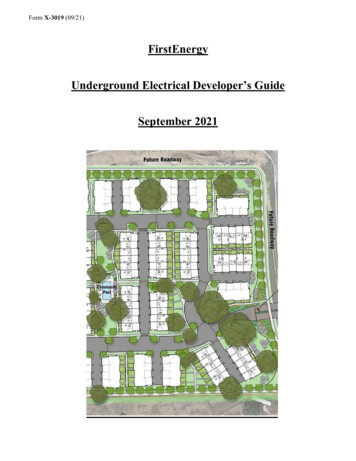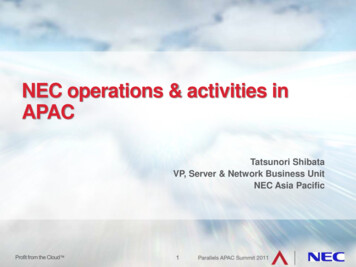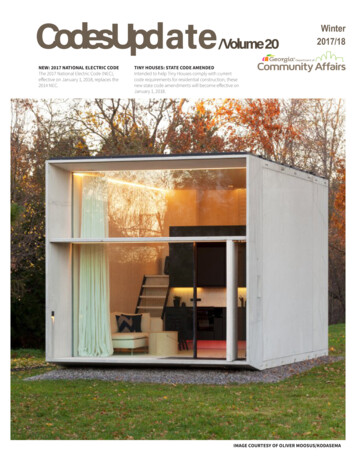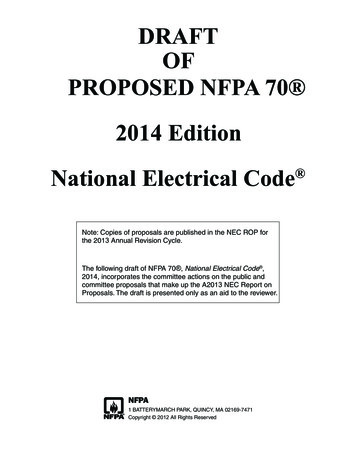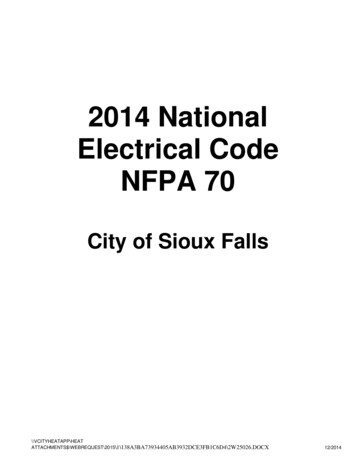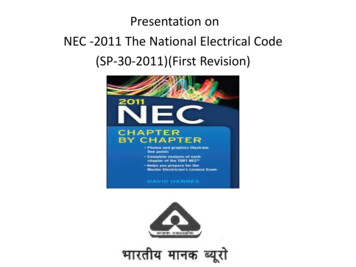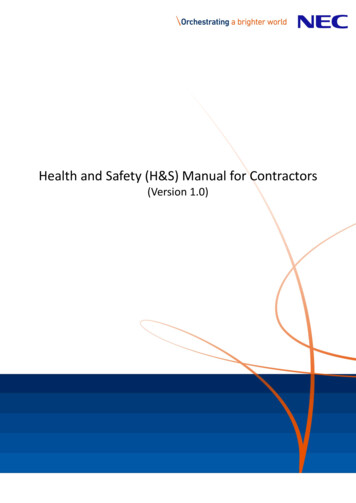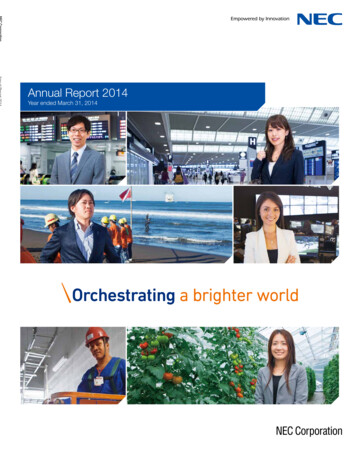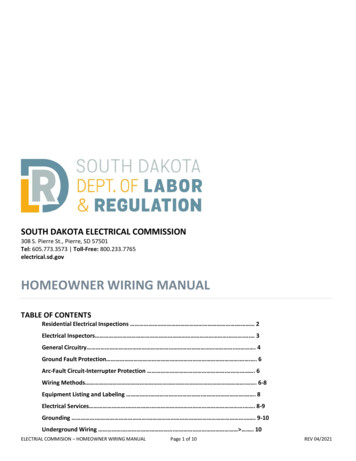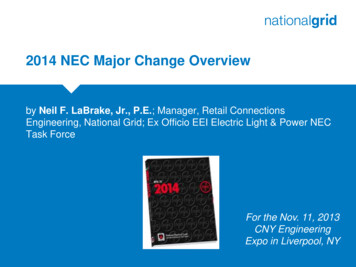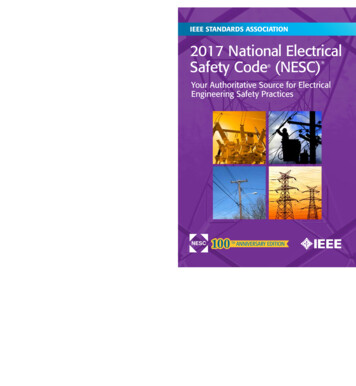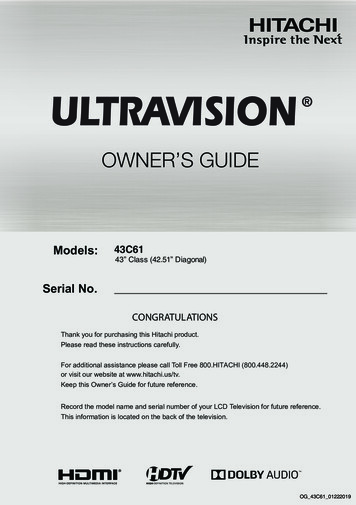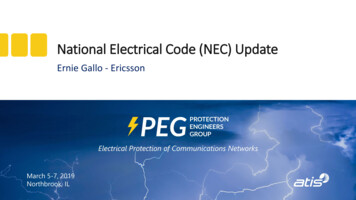
Transcription
National Electrical Code (NEC) UpdateErnie Gallo - Ericsson
Codes in Context NFPA – NEC & NFPA 70E IEEE – NESC GO-95 .GO128 .GO165 OSHA 1910.268/269 Internal M&Ps GRs and UL Listings Joint Use Agreements (JUA) UL GRs/SRs ATI Industry Safety Codes and Standards Regulatory Rules . . Legal Mandates Internal Practices Engineering Design2
Purposes/ScopesInside and On Buildings NECPurpose The practical safeguarding of personsand property from hazards arising from the use ofelectricity NFPA Fire ProtectionScope – covers installation of electrical andcommunications (electrical and fiber optic)conductors, equipment and raceways, for Public & private premises (homes, residences,buildings, similar properties) inside Load side of the demarcation point Out of Scope (Exemption) Exclusive controlof Utility (Communications, Power .)OSP NESCPurpose The practical safeguarding of persons, utility facilities,and affected property during the installation, operation, andmaintenance of electric supply and communication facilities.IEEE Electrical Safety of Public and WorkersScope - covers supply and communication facilities andassociated work practices employed by a electric supply,communications, or railway in the exercise of its functions as autility. Facilities lines, equipment, and specified infrastructure (e.g.,poles, distribution plant sub-stations, vaults ) The NESC covers similar systems under the exclusive controlof the utility and being worked by qualified persons, such asthose associated with an industrial complex or utilityinteractive system.Not a Design Guide or Instruction Manual (*)Not a Design Manual3
NEC & NFPA 70ENEC NFPA 70 - 3-year revision scheduleNEC is adopted by PUCs, legislative and regulatory bodiesNFPA 70E2018 - Consensus standard for Workplace safety forprotection against Electrical Hazards Electrical Shocks Arc Flash Harmonize with OSHA 1910 Part-S & OSHA 1926 Part-K4
NEC Adoption – August 20175
NEC (NFPA 70) RepresentationCorrelating Committee (CC) and 3 NEC Technical Committees (CMPs) CMP 1 – Purpose and Scope (Arts. 90, 100 and 110), CMP 5 – Grounding (Arts. 200, 250, 280 and 285), CMP 16 – Communications Systems (Arts. 770, 800, 810, 820, 830 and840), NEC CC - Oversight responsibility for the entire Code-making process,i.e., ensuring due process and correlating the technical committee(CMP) actions6
2020 National Electrical Code Highlights– Independence of Chapter 8, Communications Systems, remains intact– Exclusion from coverage of communications equipment under the exclusivecontrol of communications utilities remains intact– Chapter 8 reorganized Article 800 rewritten as a general article Contains general requirements applicable to Articles 805, 820, 830 and 840 New Article 805 created for communications circuits Contains requirements specific to communications circuits– Mechanical execution of work requirements is now in both Chapter 8 andArticle 110
2020 National Electrical Code Chapter 1, General, Revision Highlights Article 90, Introduction– 90.2(A), expanded to include Installations used to export electric power fromvehicles to premises wiring or for bidirectional current flow– 90.2(B)(1) revised to clarify that mobile homes and recreational vehicles are covered Article 100, Definitions– Added definitions Dormitory UnitInformation Technology RoomReconditioned
2020 National Electrical Code– Revised definitions “Attachment Plug (Plug Cap) (Plug)” revised to “Attachment Fitting” to better definethe application of the device “Fault Current” revised to “The current delivered at a point on the system during ashort-circuit condition.” “Fitting” revised to include a cable tray system “Free Air (as applied to conductors)” is simplified to state: ” Open or ventilatedenvironment that allows for heat dissipation and air flow around an installedconductor.” An informational note is added to the definition “GroundedConductor” stating that “Although an equipment groundingconductor is grounded, it is not considered a grounded conductor.”
2020 National Electrical Code Article 110, Requirements for Electrical Installations– 110.5 revised to permit copper-clad conductors– 110.12(C) now contains mechanical execution of work requirements The mechanical execution rules in Chapter 7 & 8 and Chapter 1 are in harmony– 110.21(A)(2) revised to require the removal of the original listing mark onreconditioned equipment– 110.31(A)(4) revised to require listed fire exit hardware on electrical vaultdoors– 110.33(A)(3) revised to require listed fire exit hardware on personnel doors
2020 National Electrical Code Chapter 8, Communications Systems, Reorganization Chapter 8 reorganized to simplify, eliminate redundancies– Objective: Condense repeated general requirements into single article– No technical change to requirements New Article 800, General Requirements for CommunicationsSystems– Old Article 800 now new Article 805, Communications Circuits Article 800 may be modified by Articles 805, 820, 830, 840
2020 National Electrical Code What was moved to new Article 800?– General information/requirements that apply across Articles 805, 820,830, 840 Definitions Requirement to help ensure continued independence of Chapter 8 (800.3) “Only those sections of Chapters 1 through 7 referenced in Chapter 8 shallapply to Chapter 8.” Mechanical Execution of Work" requirements remain in 830.24 and 840.24 General grounding and bonding requirements and methods General requirements for overhead (aerial) wires and cables
2020 National Electrical Code What was moved to new Article 800? General cable and primary protector and grounding block bonding andgrounding requirements General requirements for bonding and grounding at mobile homes General requirements for installation methods within buildings Applications of listed communications wires, cables, and raceways, and listedcable routing assemblies– Requirements specific to an article remain in that article
2020 National Electrical CodeChapter 8, Communications Systems, Highlighted Revisions Article 800– 800.1, Scope, permits Articles 805, 820, 830 or 840 to modify general requirements ofArticle 800– Definition, Communications Circuit, the term “electrically” is deleted as it excludes opticalfiber– Added requirement to 800.3, “Only those sections of Chapters 1 through 7 referenced inChapter 8 shall apply to Chapter 8”, further reinforcing independence of Chapter 8– Added requirement 800.3(G) for reconditioned equipment Must meet requirements of 110.21(A)(2)– Mechanical Execution of Work requirement now contained in both 800.24 and110.12(C)"
2020 National Electrical CodeChapter 8, Communications Systems, Highlighted Revisions Article 805– Optional cable marking permitted in 805.179(G) Article 820– 820.3 revised to reference general requirements of Article 800– 820.100(A) added to reference general cable grounding and bondingrequirements of 800.100
2020 National Electrical CodeChapter 8, Communications Systems, Highlighted Revisions Article 830– 830.3(A) added reference to general requirements of Article 800– 830.3(C) added requirement to meet physical protection requirements of300.4– 830.179(A) added reference to general equipment and cable requirements of800.179– Existing requirement that “Type BMU cables shall be jacketed and listed assuitable for outdoor underground use” now included in 830.179(B), (C). Optional cable marking permitted in 830.179(D)
2020 National Electrical CodeChapter 8, Communications Systems, Highlighted Revisions Article 840– Definition “Communications Service Provider” deleted in 840.2,moved to 800.3– Definition “Premises Powered” added to 840.2– 840.3(A) added reference to general requirements of Article 800– 840.160 is revised to clarify that it is the current rating of the powersource that determines whether 725.144 must be consulted
2020 National Electrical Code Chapter 2 - CMP5 has purview over Articles 200 and 250 that covergrounding/bonding practices related to the IBT, and generators thatcommunications companies use for backup powering systems andon aerial bucket trucks. All the PIs, PCs, FRs and SRs were resolved ina manner acceptable to our prepared positions and in accord withcurrent best practices used in the communications industry. IBT section 250.94 remains unchanged and remains harmonized andcorrelated with newly formatted/re-organized Chapter 8 and currentbest practices of communications industry related to grounding andbonding at the customer premises.
2020 National Electrical Code Article 250.34 and 250.26 on grounding of portable and vehiclemounted generators remain largely unchanged. The portablegenerators used by communications companies continue to becovered under Article 406 and these 250.34 .– Requirements to ground the frame of portable generators (Section250.34(C) serving premises wiring systems were added in first draftmeeting but reversed in second draft meeting to return to 2017 codelanguage. Further actions will occur next cycle or possibly duringNITMAN process.– The proposed changes in 250.34(C) would not have affected thevehicle-mounted generators used on aerial bucket trucks of carriers.
2020 National Electrical CodeThe exception in 250.119 (Identification of Equipment GroundingConductors) was modified to more clearly reflect the experienceand use of green insulated conductors in communications cablesand circuits.
2020 National Electrical Code Other issues not directly related to communications – Efforts to clarify requirements concerning separately derived powersystems with supply-side disconnects for installations such as solarpanel installations and other distributed power systems were defeatedfor Sections 250.24. The work on rules around supply-side disconnectsis expected to continue next cycle.– Suggestions to permit greater flexibility for different groundingconfigurations and table simplifications for the Equipment GroundingConductors necessary for parallel circuits in raceways (section250.122) was also defeated (i.e., left as is in 2017 code). Furtherdiscussions are expected to continue next cycle.
2020 National Electrical CodeCorrelating revisions to Sections 250.64(A) and 250.120(B) weremade to help refine and clarify the necessary limitations onaluminum conductors and splices located close to the groundwhere corrosion concerns increase because of combinedpresence of soil, contaminants and water can compromise theelectrical or mechanical connection. Although communicationscompanies do not typically use aluminum conductors, the use ofaluminum and aluminum-clad copper conductors (or otherconductor types) may become an option in the new servicesbeing deployed, new architectures being tested/deployed andpressures around the rising theft of copper ground wires.
NEC Processing Schedule
Questions ?
2020 National Electrical Code – Revised definitions “Attachment Plug (Plug Cap) (Plug)” revised to “Attachment Fitting” to better define the application of the device “Fault Current” revised to “The current delivered at
